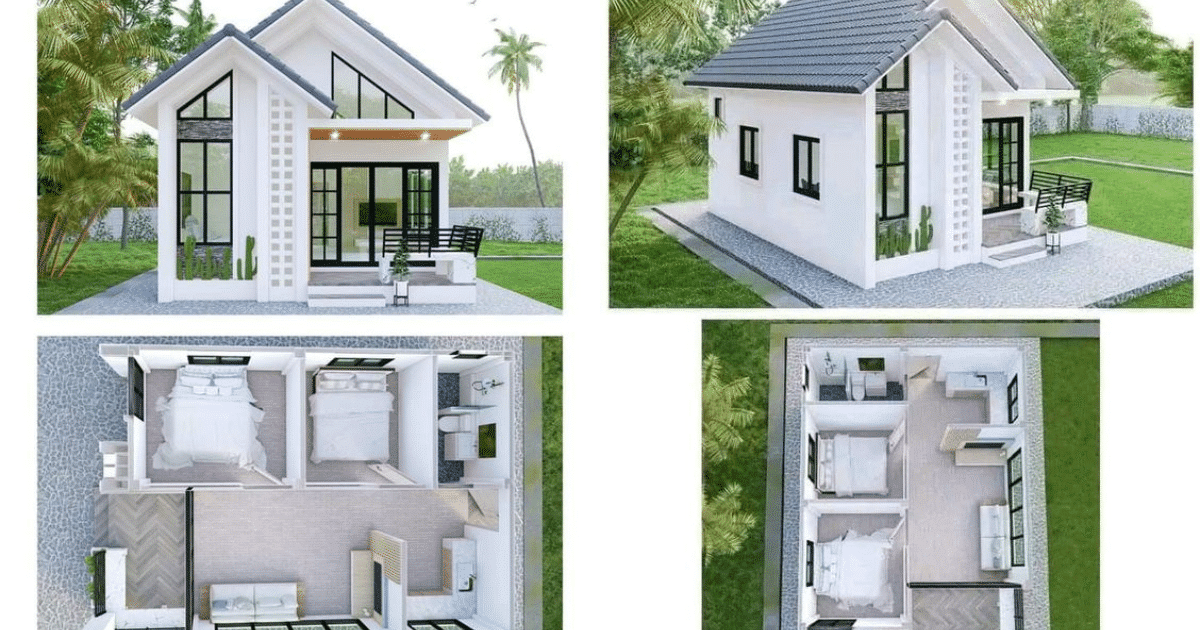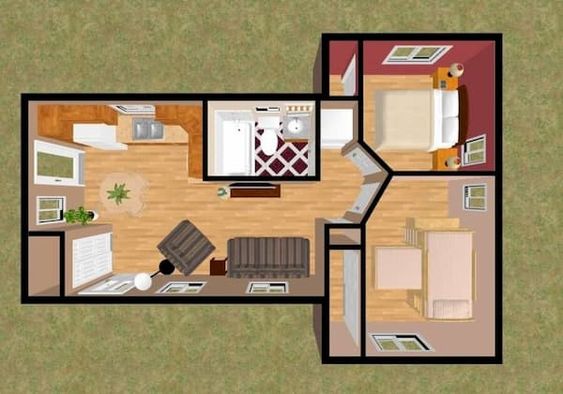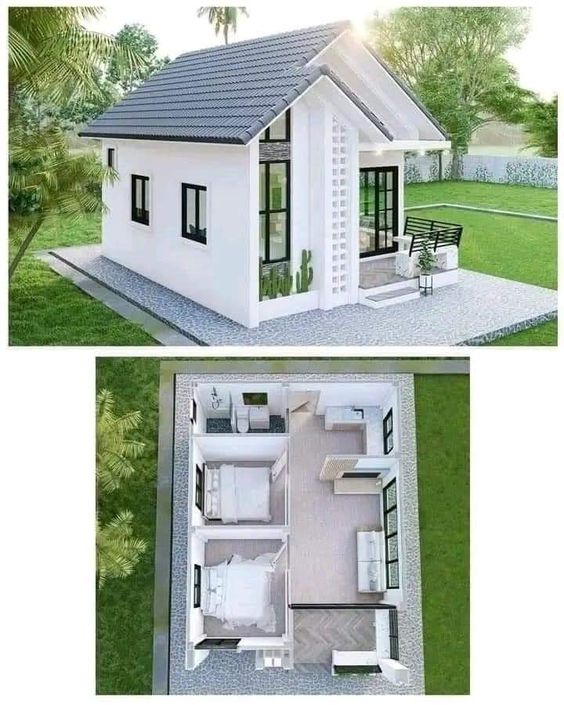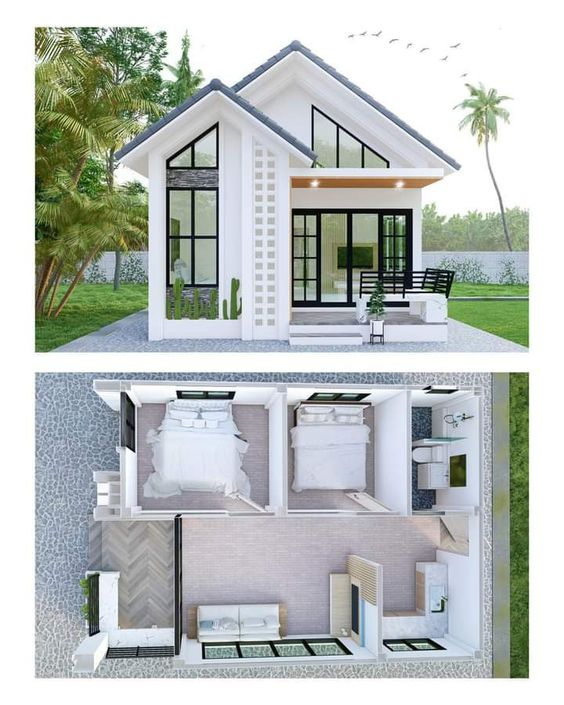Efficient 2 Bedroom Tiny House Plans

Tiny houses are gaining popularity as people seek a sustainable lifestyle that is both environmentally and financially responsible. These small houses offer functional spaces and promote minimalism, resulting in a cleaner and more organized living environment.
In addition to the aesthetic benefits, living in a tiny house also reduces construction costs, energy consumption, and maintenance time.
Sustainability is a key aspect of the tiny house lifestyle, as it minimizes the use of natural resources and reduces the carbon footprint. Furthermore, living in a tiny house encourages social bonding and a less competitive community.
Overall, adopting the tiny house lifestyle offers practical, environmental, and social advantages for those seeking a more efficient way of living.
Benefits of 2 Bedroom Tiny House Plans
2 bedroom tiny house plans offer several benefits for individuals or families looking for a small yet functional living space. These houses follow the principles of minimalism, providing a compact living space that utilizes every inch efficiently. The inclusion of two bedrooms allows for flexibility in accommodating additional family members or using the extra space as a home office or guest room. Despite their compact size, 2 bedroom tiny houses can still offer all the necessary amenities and provide a comfortable living environment. Additionally, these tiny house plans are affordable and cost-effective, making them an ideal choice for those looking to downsize or minimize their financial commitments while still maintaining a comfortable lifestyle.
Benefits of 2 Bedroom Tiny House Plans:
- Optimal utilization of space
- Flexibility in accommodating additional family members or using the extra space as a home office or guest room
- Presence of all necessary amenities
- Affordability and cost-effectiveness
Living in a 2 bedroom tiny house offers the opportunity to embrace minimalism and enjoy the benefits of a compact living space. These small houses provide practicality and comfort, allowing individuals or families to downsize without sacrificing quality of life. With the inclusion of two bedrooms, there is room for personalization and flexibility to meet different lifestyle needs. Whether it's creating a dedicated workspace, hosting guests, or accommodating a growing family, the versatility of 2 bedroom tiny house plans makes them an attractive option.
Despite their smaller size, these houses can offer all the necessary amenities for comfortable living. From a well-designed kitchen to a functional bathroom, 2 bedroom tiny houses can be thoughtfully planned to maximize functionality without compromising on convenience. Additionally, the affordability of these tiny house plans makes them an accessible choice for individuals or families seeking a more financially sustainable lifestyle.
Another advantage of 2 bedroom tiny house plans is their potential for customization. With efficient design strategies and creative furniture placement, these houses can provide a comfortable living space for individuals with different needs and preferences. The compact layout encourages a more minimalist lifestyle, allowing residents to focus on what truly matters and avoid accumulating unnecessary possessions.
Design Ideas for Small Houses
When it comes to designing small houses, efficiency is key in maximizing space utilization and creating a comfortable living environment. Here are some design ideas to make the most of your modern two-bedroom tiny home:
- Create Efficient Layouts: Focus on smart space planning to ensure every square inch is utilized effectively. Consider open floor plans that seamlessly connect different areas of the house and eliminate unnecessary partitions.
- Optimize Space with Multi-functional Furniture: Invest in furniture pieces that serve multiple purposes. For example, a sofa bed can double as a guest bed, or a coffee table with built-in storage can provide additional space for stowing away belongings.
- Introduce Sliding Doors and Room Dividers: To maximize the flexibility of your two-bedroom tiny home, utilize sliding doors or room dividers to create privacy when needed, while maintaining an open and airy feel. This allows for efficient use of space without sacrificing functionality.
- Embrace Natural Light: Incorporate large windows and skylights to let natural light flood into your small house. This not only creates a sense of spaciousness but also promotes a bright and inviting atmosphere.
- Incorporate Modern Design Elements: Clean lines, minimalist aesthetics, and a neutral color palette can enhance the overall appeal and visual flow of your small house. Choose contemporary fixtures and furnishings that complement the space, making it feel both modern and cozy.
By implementing these design ideas, you can create efficient small house layouts that are both functional and visually pleasing, achieving a modern two-bedroom tiny home that meets your needs and preferences.
The Advantages of Energy Efficiency in Tiny Homes
Energy efficiency plays a vital role in the world of tiny house living. By incorporating energy-efficient features into the design of these small homes, homeowners can enjoy numerous benefits such as reduced energy consumption, lower utility bills, and a smaller environmental footprint. Let's explore the advantages of energy efficiency in tiny homes.
1. Reduced Energy Consumption
One of the primary advantages of energy efficiency in tiny homes is the significant reduction in energy consumption. By utilizing energy-efficient appliances, LED lighting, and smart home technology, homeowners can minimize their energy usage without sacrificing comfort or convenience. This not only reduces their environmental impact but also helps save on energy costs.
2. Lower Utility Bills
With the energy-efficient design of tiny homes, homeowners can experience substantial savings on their monthly utility bills. Efficient insulation, solar panels, and rainwater harvesting systems are just a few examples of features that help minimize utility expenses. By generating their own electricity through renewable sources and conserving water, homeowners can live more sustainably while enjoying financial advantages.

3. Environmental Sustainability
Tiny homes are an environmentally friendly housing option, and energy efficiency plays a crucial role in maximizing sustainability. By generating clean energy through solar panels and reducing overall energy consumption, tiny homeowners contribute to a greener future. Additionally, energy-efficient design elements like proper insulation and efficient heating and cooling systems minimize the ecological footprint of these homes.
4. Comfortable Living Spaces
Contrary to popular belief, energy-efficient homes can provide comfortable living spaces. With proper design and planning, tiny homes can incorporate insulation, ventilation systems, and efficient heating and cooling solutions to ensure a comfortable indoor environment. Homeowners can enjoy cozy warmth in the winter and refreshing coolness in the summer, all while conserving energy.
5. Enhancing the Tiny Home Lifestyle
Energy efficiency seamlessly integrates with the tiny house lifestyle, magnifying its benefits. The philosophy of minimalism and sustainability in tiny homes align perfectly with energy-efficient living. By embracing eco-friendly practices and reducing their carbon footprint, homeowners can fully embrace the spirit of the tiny house movement while enjoying its practical and financial advantages.
In summary, energy efficiency in tiny homes offers multiple advantages, including reduced energy consumption, lower utility bills, enhanced environmental sustainability, and comfortable living spaces. It is a vital aspect of the tiny house lifestyle and perfectly complements the principles of minimalism and sustainability. By making conscious choices in design, appliance selection, and energy usage, homeowners can enjoy a more efficient and sustainable way of living.

Overcoming Challenges in Tiny House Living
While tiny house living offers numerous benefits, it is important to acknowledge the challenges that come with compact living spaces. Limited storage space and tight living quarters can initially seem daunting for individuals or families transitioning to a tiny house lifestyle. However, with proper organization and creative storage solutions, these challenges can be effectively addressed.
"Living in a tiny house requires thinking outside the box when it comes to storage. Every square inch counts, so it's essential to maximize vertical space and make use of multi-functional furniture," suggests interior designer Emily Adams.
Embracing the principles of minimalism is key to conquering the challenges of tiny house living. Letting go of unnecessary possessions and adopting a simplified lifestyle may require a shift in mindset. However, many people find that the rewards of experiencing a meaningful and environmentally responsible lifestyle far outweigh these initial challenges.
Although living in a tiny house requires careful consideration and adjustment, it presents an opportunity for individuals to prioritize what truly matters. With efficient design strategies and smart space utilization, individuals can create a fulfilling and sustainable lifestyle within the limited square footage of a tiny house.
Effective Strategies for Overcoming Challenges
To successfully overcome the challenges of tiny house living, here are some effective strategies:
- Maximize storage: Use vertical space, invest in space-saving furniture, and utilize under-bed storage or built-in shelving solutions.
- Adopt a minimalist approach: Let go of unnecessary possessions and embrace a clutter-free lifestyle to create more space and enhance the overall ambiance of your tiny house.
- Design with purpose: Efficiently plan the layout of your tiny house to ensure every square inch serves a purpose. Consider multifunctional furniture and utilize room dividers or sliding doors for privacy when needed.
- Organize and declutter regularly: Implement regular decluttering sessions to prevent accumulation of unnecessary items and maintain an organized living space.
- Utilize outdoor space: Make the most of your outdoor area by creating functional outdoor living spaces, such as a patio or garden, to extend the usable space of your tiny house.
With these strategies, individuals can overcome the challenges of living in a tiny house and create a harmonious and fulfilling living environment that aligns with their values and goals.



The Freedom and Flexibility of Tiny Home Living
One of the unique advantages of tiny home living is the freedom and flexibility it offers. Thanks to their compact size and portable design, tiny homes provide the opportunity to live a more nomadic lifestyle and explore different locations. Whether it's moving to a new city or traveling across the country, tiny homeowners have the freedom to take their home with them, enabling them to experience new environments and cultures. This flexibility not only allows for a sense of adventure but also challenges the conventional concept of home ownership and encourages a more minimalist and experiential approach to life.
With the ability to travel and live in different places, tiny homeowners can embrace a lifestyle that values experiences and freedom. Unlike traditional homeowners, they are not tied down to a fixed location and can adapt to their changing interests, work opportunities, or desire for new adventures. This level of flexibility empowers individuals to truly live life on their own terms, without being confined by the constraints of a stationary home.
Design Ideas for Small Houses
When it comes to designing small houses, maximizing space utilization is key. Here are some design ideas for small houses:
- Utilize multifunctional furniture: Invest in furniture pieces that serve multiple purposes, such as storage beds or folding tables, to optimize space efficiency.
- Create an open layout: Use an open floor plan or remove unnecessary walls to create a sense of spaciousness and flow between different areas of the house.
- Maximize natural light: Incorporate large windows, skylights, and light-colored walls to bring in natural light and make the space feel brighter and more open.
- Implement smart storage solutions: Utilize hidden storage compartments, built-in shelves, and vertical storage options to maximize storage capacity without cluttering the living space.
By implementing these design ideas, small houses can provide a comfortable and functional living environment while making the most of limited space.
Quote
"Living in a tiny home gives you the freedom to prioritize what truly matters to you and experience life in a whole new way." - Emily Jones, Tiny Homeowner
Comparison of Tiny Home Living and Traditional Home Ownership
| Aspect | Tiny Home Living | Traditional Home Ownership |
|---|---|---|
| Flexibility | Can easily move and travel with the home | Tied to a fixed location |
| Maintenance | Requires less maintenance and cleaning | More maintenance and cleaning responsibilities |
| Cost | Lower construction and maintenance costs | Higher construction and maintenance costs |
| Environmental Impact | Minimal carbon footprint and energy consumption | Higher carbon footprint and energy consumption |
By comparing tiny home living to traditional home ownership, it becomes clear that tiny homes offer a unique combination of freedom, cost-efficiency, and sustainability.
Conclusion
In conclusion, 2 bedroom tiny house plans provide an efficient and sustainable living solution for those seeking a minimalist lifestyle. These small houses offer functional and comfortable living spaces, promoting environmental responsibility and financial efficiency. By incorporating creative design ideas and energy-efficient features, tiny homes maximize space utilization and minimize the ecological footprint.
Although challenges may arise from living in a small space, the benefits of a simplified lifestyle and the freedom to explore new opportunities outweigh these obstacles. Embracing a tiny house lifestyle allows individuals or families to adopt a more sustainable and meaningful way of living, reducing their environmental impact while still enjoying a comfortable home.
With efficient small house plans, sustainable living becomes a reality. By choosing a tiny house, individuals contribute to a more environmentally conscious society and experience the advantages of a simpler, more intentional life. From financial savings to reduced energy consumption, the benefits of tiny houses extend beyond their compact size. It's time to embrace the advantages of efficient living and join the growing community of tiny homeowners.
FAQ
What are the benefits of 2 bedroom tiny house plans?
2 bedroom tiny house plans offer a compact living space that promotes minimalism and efficient use of space. They provide flexibility for accommodating additional family members or using the extra room as a home office or guest room. Despite their small size, these houses can still provide all necessary amenities and a comfortable living environment.
What design ideas are suitable for small houses?
When designing small houses, it is essential to focus on creating efficient layouts that maximize space utilization. Incorporating multi-functional furniture and storage solutions can help optimize space and create a sense of openness. Sliding doors or room dividers can create privacy when needed, while using natural light through large windows and skylights can make the space feel more spacious and inviting.
How can energy efficiency be incorporated into tiny homes?
Energy efficiency is crucial in tiny house living. By using energy-efficient features like solar panels, rainwater harvesting systems, and insulation, homeowners can significantly reduce energy consumption and minimize their environmental impact. Utilizing energy-efficient appliances and implementing smart home technology can further enhance energy efficiency in 2 bedroom tiny homes.
What challenges are involved in tiny house living?
Limited storage space and tight living quarters can be a challenge for some individuals or families. However, with proper organization and creative storage solutions, these challenges can be effectively addressed. Additionally, adjusting to a simplified lifestyle and letting go of unnecessary possessions may require a shift in mindset. But many people find that the rewards of a meaningful and environmentally responsible lifestyle outweigh these challenges.
What is the freedom and flexibility of tiny home living?
Tiny homes offer the freedom to live a more nomadic lifestyle and explore different locations. Their portable design allows homeowners to take their home with them, enabling them to experience new environments and cultures. This flexibility challenges the conventional concept of home ownership and encourages a more minimalist and experiential approach to life.